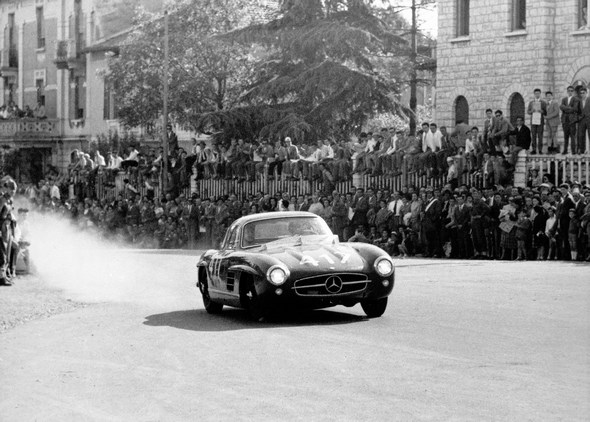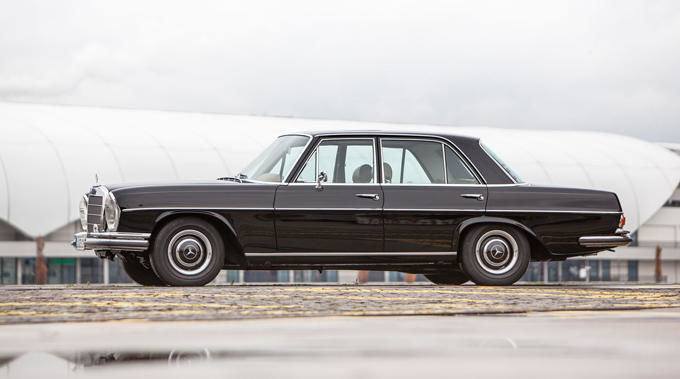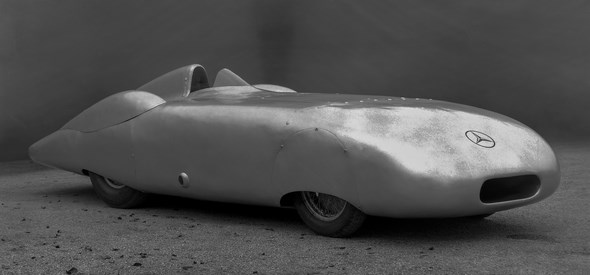Historical SLs in the wind tunnel
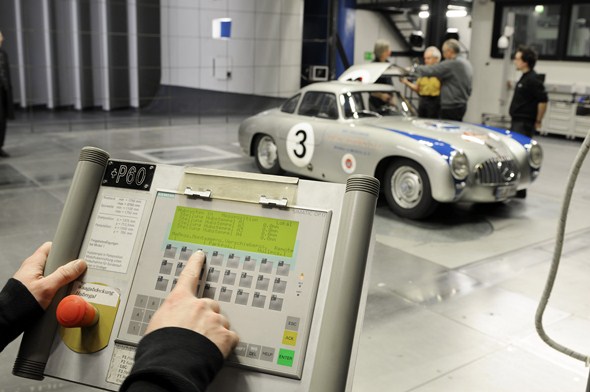
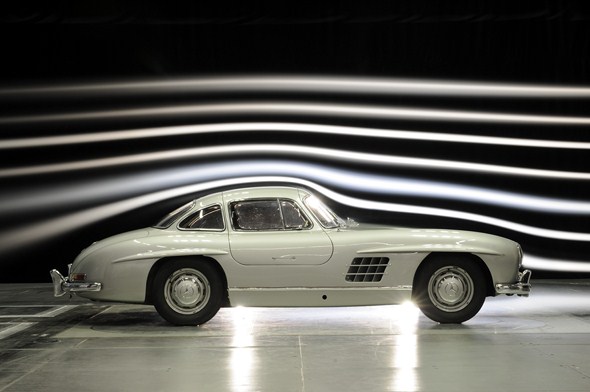
Mercedes-Benz Classic
- Measurements on the 300 SL (W 194 series) and 300 SL (W 198 I series) as well as comparative measurements on the 300 S (W 188 series)
- The results of the two SL measurements are unexpectedly close
- The Mercedes-Benz 300 S has a significantly better drag coefficient than expected
Stuttgart – New cars are constant objects of study in the wind tunnel. They are subjected to tests in order to optimise them in different ways – for example, to reduce fuel consumption, but also to improve wind noise or splash water flow.
Historical vehicles, on the other hand, are seldom indeed guests in the wind tunnel, for their development has long since been finished. However, the values measured in the wind tunnel are not always available for them, or sometimes there are indeed measured values, but these cannot be compared with the figures obtained in today’s tests.
For reasons of historical interest, in January 2012 Mercedes-Benz Classic thus examined two SL model series in the company’s own wind tunnel at its Stuttgart-Untertürkheim plant using modern-day measuring methods– the first SL (W 194 series) from 1952, and the 1954 series-production 300 SL (W 198 I series) sports car.
In order to have a contemporary comparison vehicle, a 1951 Mercedes-Benz 300 S (W 188 series), a luxurious, sporty touring car, was also examined. This vehicle had lent some of its technology to the first post-war Mercedes-Benz sports car.
The most important results: the 300 SL (W 194 series) racing car has a drag coefficient cD = 0.376. It is thus around 20 per cent better – that is, considerably better – than its contemporary comparison vehicle, the 300 S (W 188 series), for which a value of cD = 0.462 was obtained.
This result underscores the efforts of the engineers and designers back then to attain a low drag coefficient as an important prerequisite for the SL’s racing success – which the car then went on to achieve in the course of the 1952 racing season at different international motorsport events, for example at Le Mans or in the Carrera Panamericana in Mexico. The 300 SL (W 198 I) series-production sports car returned a drag coefficient value of cD = 0.389.

The wind tunnel in Stuttgart-Untertürkheim itself is historical: it hearkens back to the 1930s and the legendary FKFS-Institut (Forschungsinstitut für Kraftfahrwesen und Fahrzeugmotoren Stuttgart) or Stuttgart Research Institute for Automotive Engineering of Stuttgart Professor Wunibald Kamm, who enjoyed similar fame for his importance in the field of aerodynamics.
The tunnel is based on the so-called Göttinger design principle with a three-quarter open test section. In the mid-70s the then Daimler-Benz AG took over the wind tunnel. Today it is one of several test installations of its kind in the Group.
Exciting beyond measure…
- Three historical vehicles in an historical wind tunnel
- The results of the two 300 SL (W 194 and W 198 I series) are similar
Morning of the 23rd of January 2012: the three cars are standing at the ready. Little do the workers and employees at the Mercedes-Benz Untertürkheim plant suspect of the bustle of activity going on behind the walls of the wind tunnel facilities. For eight hours the 5-Megawatt electric motor will set the fan blades in motion to drive the vast volume of 9000 cubic metres of air.
The object is to determine the relationship among the three study objects in terms of their surface and air resistance values – the three cars are closely related technically: the drive system of the W 194 is based in part on that of the W 188, while the W 198 is based on the W 194.
So as to compare them more directly, the three vehicles were measured without underbody panelling. Today these three classics are usually driven in normal road traffic without underbody panelling in any case, in order to permit easier access to service points and so that the vehicle interior does not heat up.
The following programme is scheduled: 10 point measurements of the cD values with wind velocities of 130 km/h and 200 km/h. In addition, the vehicle frontal area (A) as well as the coefficients of lift at the front axle (cAF) and at the rear axle (cAR) were determined.
The day promises to be exciting. With the first measurement, that of the 300 S, the most diverse figures, guesses and estimates buzz around the hall – all of the estimates high because of the vehicle design, which presents a relatively large surface to the wind. The frontal area of the 300 S with exterior mirror, 2.28 square metres, is thus no surprise.
No-one yet suspects that no guess or estimate will hit the mark. At the wind tunnel control station tense concentration dominates the scene.
When the first values measured for the 300 S come from the ticker and are printed out, they reveal an average drag coefficient of cD = 0.468 at a blown wind speed of 130 km/h and cD = 0.482 at 200 km/h: a murmur of approval goes through the room.
For comparison: the 190 SL (W 121 series), which appeared in 1955 and thus four years after the 300 S, achieves a drag coefficient cD of 0.461 with a hard top, while the 1963 Mercedes-Benz 230 SL (W 113 series), the famous “Pagoda”, has a drag coefficient cD of 0.515. This shows the Mercedes-Benz 300 S in a very good light indeed.
For the 300 S, the cD × A value, the product of the frontal area A and the drag coefficient of the vehicle body cD, results in 1.067 at a wind speed of 130 km/h, and 1.100 at a speed of 200 km/h.
As the coefficient for lift at a wind speed of 130 km/h for the front axle (cAF = 0.268) is virtually identical to that for the rear axle (cAR = 0.270) there is no pitching moment and consequently a stable vehicle attitude. At a wind speed of 200 km/h the 300 S experiences a stronger load relief of the front axle with a resulting front axle lift coefficient cAF = 0.293 and rear axle lift coefficient cAR = 0.267.
However, both these values lie in the realm of purely theoretical knowledge since the 300 S has a top speed of 175 km/h.
The 300 SL in the wind tunnel
No less was the tension before the start of the test series with the second vehicle, the 300 SL (W 194 series). This is the original 1952 racing season car.
It comes as no surprise then, that at 1.784 square metres, the frontal area is 22 per cent lower than that of the 300 S. After all, reduction of the drag coefficient is one of the key points in the requirement specifications for the racing car. Its cD values, 0.376 (wind speed 130 km/h) and 0.383 (wind velocity 200 km/h) are almost 20 per cent better than those of the 300 S. In the case of the cD × F value, more important for the driver, (multiplication of the vehicle frontal area by the aerodynamic quality of the body, the drag coefficient), 0.670 and 0.683, depending on wind speed, the 300 SL (W 194 series) is even 37 per cent better than the 300 S.
The lift coefficient at the front axle, cAF = 0.305 and 0.318 and at the rear axle, cAR = 0.149 and 0.140, show a significant load transfer from the front axle at high speeds.
At the same time the results of the measurements showed how far from reality was the drag coefficient cD = 0.25 value determined in the 1950s with a 1-in-5 clay scale model of the W 194 – and how great an influence, for example, the air flow through the engine compartment (which of course the clay model did not have) has on the overall air resistance of the car.
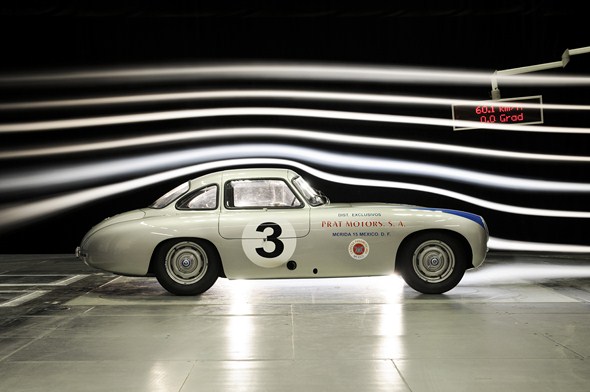
On the other hand in the wind tunnel measurements of today the series-production 300 SL (W 198 I series) held a surprise. With a frontal area of 1.757 square metres the car is even a little more svelte than the 300 SL (W 194 series) of 1952 and can thus – with the cD × A value – partially compensate its cD value which is less favourable than that of the 1952 racing car (W 194 series ).
The cD values returned were 0.389 and 0.397, at wind speeds of 130 km/h and 200 km/h, respectively, the resulting cD × A figures, 0.685 and 0.697, respectively.
The lift coefficients of the 300 SL (W 198 series) production sports car show an even greater load transfer from the front to the rear axle at increasing speeds than is the case for the 300 SL (W 194 series ) racing car. At 130 km/h the cAF is 0.334 and at 200 km/h it is 0.358. The cAR figure is 0.125 at 130 km/h and 0.108 at 200 km/h.
Apart from the bare measured values the tests revealed that specifically the two SL models generate a particularly strong lift at the front axle that increases at higher speeds, which in turn makes the cars susceptible to side winds. This is confirmed by the high yaw moment under a diagonal incident wind flow direction of 20 degrees.
For the 300 S model (W 198 series) the investigation showed a strong flow break at the top edge of the radiator grille, a separation which remains perceptible as far back as the windscreen. By contrast, the transition from the windscreen to the roof turned out to be better than expected. However, the airflow breaks away again some 30 to 50 millimetres above the rear window and meets the vehicle body again on the boot lid.
Both SL models show good airflow over the front area. However, the lower edges of the vehicle body are too high, in particular in the case of the W 194, leaving the vehicle underbody unprotected, which results in the high lift forces at the front axle. Airflow around the windscreen, the A-pillars and the roof is good, but in the W 194 the airflow breaks off at the rear window rubber surround, to later hug the car again at the boot lid.



